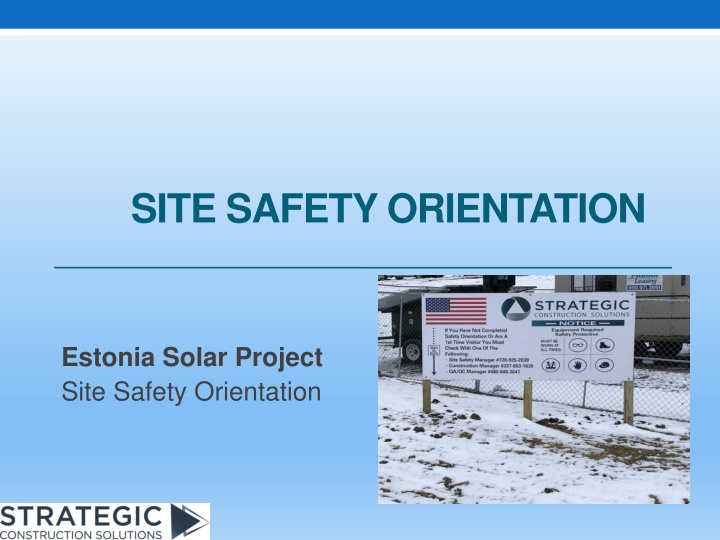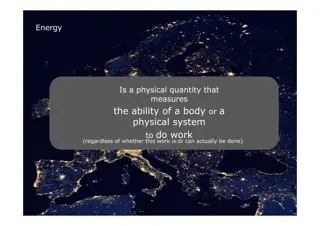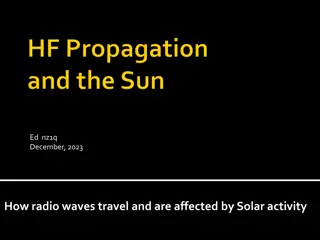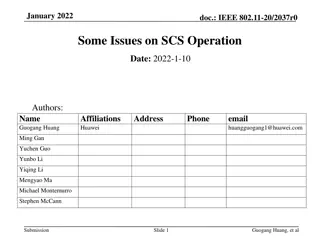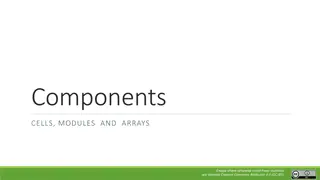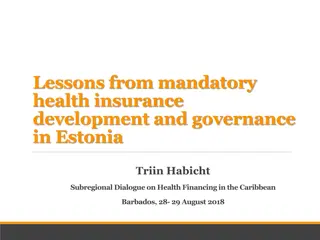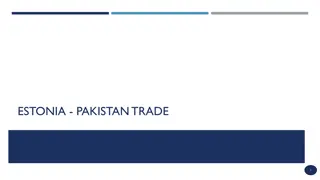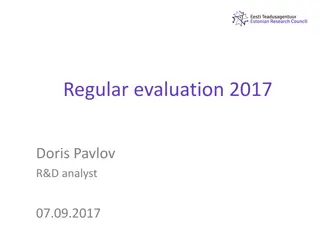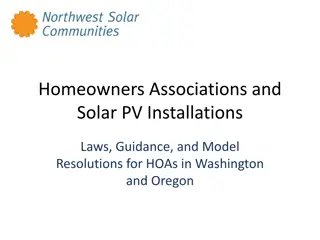SCS Safety Orientation and Philosophy in Estonia Solar Project
In the Estonia Solar Project site safety orientation, key safety principles, fundamentals, and site rules are reviewed. The philosophy emphasizes the importance of safety in all operations, with zero tolerance for policy violations. Definitions of terms like substation and high voltage transmission lines are explained, along with stormwater pollution prevention plans. The Safety Champion philosophy prioritizes event-free operations and personal accountability for safety. Employee and contractor safety are equally critical for maintaining a safe work environment.
Download Presentation

Please find below an Image/Link to download the presentation.
The content on the website is provided AS IS for your information and personal use only. It may not be sold, licensed, or shared on other websites without obtaining consent from the author.If you encounter any issues during the download, it is possible that the publisher has removed the file from their server.
You are allowed to download the files provided on this website for personal or commercial use, subject to the condition that they are used lawfully. All files are the property of their respective owners.
The content on the website is provided AS IS for your information and personal use only. It may not be sold, licensed, or shared on other websites without obtaining consent from the author.
E N D
Presentation Transcript
SITE SAFETY ORIENTATION Estonia Solar Project Site Safety Orientation
2 Today We Will Review key philosophy, principles, and fundamentals of SCS safety Review site background, community, history, and any safety issues in the site environment Review site rules Site Safety Manager- Jimmy Peacock (903) 519-7264
3 Safety Philosophy, Principles, and Fundamentals
4 Removal from Site Zero tolerance for blatant, willful violations of company policies regarding certain aspects of: Fall protection Excavation and trenching Lockout/tagout(LOTO) Confined space entry Motor vehicle operation or equipment operation Crane and erection safety Working near energized power lines without proper safeguarding Drugs and/or alcohol abuse Not tied off on top of nacelle or inside of hub Fighting Abuse of landowners
5 Definitions Substation: is a high-voltage electric system facility. It is used to switch generators, equipment, and circuits or lines in and out of a system. It also is used to change AC voltages from one level to another, and/or change alternating current to direct current or direct current to alternating current High voltage transmission lines: deliver electricity over long distances. The high voltage is required to reduce the amount of energy lost during the distance. Unlike other energy sources such as natural gas, electricity can't be stored when it is not used. Stormwater Pollution Prevention Plan (SWPPP): is a plan created by constructors to show their plans for sediment and erosion control. Typically these plans are part of an overall design that details procedures to be followed during various phases of construction Best Management Practices (BMPs): is a term used in the United States and Canada to describe a type of water pollution control JHAs: An analysis of the hazards and risk associated which focus on identifying and controlling hazards. ... The process will identify existing and potential hazards and assessing the risk and identify methods to eliminate or protect against the hazard.
6 SCS s Safety Philosophy Champion safety as our highest priority. Event free operation can only be attained if safety is reflected in every behavior personnel safety, contractor safety, and public safety Foster a safety culture in which everyone believes and demonstrates that accidents, injuries and illnesses are preventable and everyone understands their responsibility for maintaining such a workplace Ensure personal accountability by employees and contractors in ensuring their safety, the safety of those working around them, and the safety of the public Believe you can make a difference Demonstrate a desire and commitment to continuously improve We believe that employee and contractor safety are synonymous, as both hold the same responsibilities to ensuring we remain safe in all of our work environments
7 SCS s Safety Principles Employees are expected to take an active role in their personal safety All safety incidents can be avoided if appropriate use of safety processes, procedures, tools and past experiences are shared and communicated As a company, we aspire to ensure employees return from work each day as healthy as they come Our work is never so urgent, nor our schedule so important, that work cannot be performed safely Uphold a Zero Tolerance culture
8 SCS s Zero Tolerance Culture Unsafe behaviors are corrected and coached immediately Unsafe conditions are reported and corrected as soon as possible Working any other way is not acceptable
9 Safety Fundamentals Accept personal accountability for your safety and those working around you All personnel are responsible for continually assessing their safety work practices Focus on hazard identification/assessment then hazard prevention/control Report all work-related injuries, illnesses, unsafe conditions or practices and near misses to supervision and site management
10 Safety Fundamentals (Cont d) Be responsible for your own safety Don t put yourself in potentially dangerous situations Assess the hazards (Job Hazard Analysis Checklist will be covered this in more detail) Be aware of your surroundings Ensure a clean and uncluttered workspace (good housekeeping ) Identify potential for events Slips, trips, falls Struck or struck by (falling objects, sharp objects, etc.) Over exertion (lifting, pushing, pulling, reaching, twisting, climbing) Cumulative trauma/repetitive motion Control or prevent the hazard Remove/disable the potential hazard Change behavior or process to mitigate the hazard
11 Safety Fundamentals (Cont d) Know and understand SCS s safety principles, human performance principles, and human error prevention Leverage Human Performance Tools to enable you to be safer and create a safer environment for others Utilize checklists, forms, and other tools (Job Hazard Analysis, Pre-Job Briefings, Tailgate Meetings, etc.) if they apply and can help you create a safer environment Consider and use the appropriate equipment and personal protection for any work Conduct thorough investigations of incidents
12 Safety Fundamentals (Cont d) All personnel should maintain a questioning attitude and always look to answer the 4 Critical Questions What are the CRITICAL STEPS in the task? What are the ERROR LIKELY situations? What is the WORST THING that can go wrong? What DEFENSES are we relying upon?
13 Safety Fundamentals (Cont d) Human Performance Tools Self-Check (STAR) Stop, Think, Act, Review Peer Check First Check Concurrent Verification Independent Verification Workers Observing Workers (WOW) Pre-Job Brief (PJB)
14 Safety Fundamentals (Cont d) Self-Check (STAR) Stop Pause before performing your task, to enhance the attention to detail. Attempt to eliminate current or potential hazards. Think Understand specifically what is to be done before performing the task. Question the situation by trying to identify all information pertinent to the task or job. Determine if the task is appropriate for the given conditions and consider both the expected responses and results. Decide what contingency plans are required and get responses to any unanswered questions. Act Conduct the activity as intended or agreed to. Review Verify that the actual response is the expected response/result. Take the agreed-to contingency action is the actual response was unexpected.
15 Safety Fundamentals (Cont d) Workers Observing Workers (WOW) Observe yourself and your colleagues Ensure employees and contractors take a personal interest in the safety of anyone working within an SCS facility Actively provide feedback to anyone when unsafe behaviors and unsafe acts are observed (below are some suggested approaches) Leverage humor to help coach any unsafe behaviors Show you care about your colleagues safety Assume they don t realize what is unsafe about their behavior Ask permission to provide some feedback on the situation or behavior Positively reinforce those behaviors that are good Lead by example
16 Safety Fundamentals (Cont d) Pre-Job Brief (PJB) Performed for all physical work activities Purpose Ensure all affected personnel understand the scope and expectations of a given work activity Create an environment of open, candid communication where the work can be discussed and evaluated for all to understand Conducted before the start of each job, and involves all workers that will be participating on the particular job Cover at least the following: Hazards associated with the job Work procedures involved Special precautions Energy source controls PPE requirements
17 Safety Fundamentals (Cont d) Pre-Job Brief (PJB) Cont d At least one PJB conducted before each day, or before a new shift begins work Additional PJB shall be held if any significant changes occur which might affect the safety of the employee Working alone does not prevent you from conducting your own, informal PJB, using the same evaluation criteria and elements Site employees are responsible for ensuring that these are being held, and that they are being done correctly and appropriately (even if the contractor is leading and owning the PJB) PJB should answer the 4 Critical Questions (reminder below) What are the critical steps in this task? What are the error likely situations? What is the worst thing that can go wrong? What defenses are we relying upon?
18 Safety Fundamentals (Cont d) Pre-Job Brief An Example of What Good Looks Like PJB leader has adequately prepared for the PJB knows the content, the hazards, and the work PJB is done in an appropriate location that allows personnel to pay attention and hear the review All required attendees are present and attentive Brief properly covers Job purpose, expected results, and scope Roles and responsibilities of personnel involved Human performance tools discussed and reviewed Actions and safe practices to prevent any errors and review of error-likely situations Review and discussion of potential hazards Review of communication requirements Review of any safety or environmental requirements Discussion of conditions that would result in work stoppage or supervisor notification Review of any lessons learned from recent or similar jobs Review, and answer of the 4 Critical Questions PJB leader does not employ a sense of urgency that promotes the atmosphere of time pressure to complete the task PJB leader solicits participation
19 Site Background, Community, History, and Environment
20 Site Background and History ENEL, through its U.S. renewable subsidiary Enel Green Power North America , has started construction of the Estonia Solar Project in Cooper Texas. The project will have a capacity of 250 MW + 70 MW of energy storage. It will cover 2,000 acres.
21 Site Background and History (CONT D) Site currently used for agricultural farm land. Tree Cover- Moderate to thick: Oaks, hackberry, china berry, willow Known hazards include farm equipment, spray from pesticides, herbicides, fungicides and fertilizers. Always stay upwind of any spray activities Steep drainages ditches along roadways. Gravel roadways with heavy equipment traffic.
22 Community Relations Maintain a Good Neighbors perspective Observe speed limits (beyond limits already in place at the site) Maintain respect for the land and natural preserves in the area Act in a professional manner, representing your company, and SCS, in a positive light with the local community Avoid backing up in non participants driveways Protesters / Media Do not engage Call an SCS/ ENEL representative or your supervisor
23 Environment and Safety Ticks and spiders in the area Deer Tick 0 Total cases of lyme disease confirmed in Throckmorton County (2000 to 2018) Deer Tick
24 Environment and Safety (CONT D) Spiders Types of Spiders House spiders consist mostly of these four types of spiders; Black Widow Venomous house spiders, Bulbous, shiny black with, red hourglass on its abdomen. Builds chaotic webs. Brown Recluse Necrotic venom house spiders, violin- shaped marking on its dorsum. 6 and 20 mm in size, but may grow larger.. Wolf Spider Harmless house spiders, Very large, 1 inch in length, tan stripe. Does not hang out in webs. Cellar Spider Harmless house spiders, very skinny, long legs, light brown. Builds webs throughout the home. Builds chaotic webs
25 Environment and Safety (Cont d) Best method of removal Attempt to remove tick or critter with tweezers Do not leave the head Apply antibiotic Seek medical treatment if rash or swelling occurs Keep the tick for the medical examiner Spider nesting can often be found in or under: Conex boxes Pallets Office boxes Wooden pallets Delivered or stages supplies and equipment Wooden spools Port-a-potties/Check under the seat Typically warm areas
26 Environment and Safety (Cont d) Venomous Snakes Rattlesnakes are not the only venomous snakes in Texas, though they are by far the most common and tend to strike the most fear in Texans hearts. Next on the list of most feared snakes is the cottonmouth, or water moccasin. Ranging in color from a splotchy gray to nearly black, it is commonly found around swampy, slow-water terrain and habitat. The copperhead is a small, beautifully colored and patterned snake found mostly in yards and wooded areas of East Texas but also Central Texas. It is common in cities and towns and is known to deliver bites to children playing outside or adults walking on the lawn. Coral snakes, which deliver neurotoxic venom, are found throughout the eastern half of the state, including Central Texas. They are small, slender snakes and must literally chew on a person to get their venom into the bite.
27 Environment and Safety (Cont d) Nonvenomous Snakes Coachwhip A slender, mostly light brown to tan snake that will kill and eat rattlesnakes, it doesn t attack people by whipping their legs, as folklore suggests. It eats birds, small reptiles and almost anything else it can catch and swallow. The Central Texas whip snake, a member of this family, has a black head and a black- and-white pattern on the rest of its body. Texas rat snake Maybe the most common snake in Texas, this acrobatic climber feeds on rats and mice, birds and birds eggs. It can grow to be quite large but is not dangerous to humans. It will bite, though, and protect itself with an obnoxious musk. Hog-nosed snake Most common in East Texas, this little snake has an upturned nose and feeds on insects. It will play dead if threatened. It has a brownish to gray body with broken patterns of brown and black on its back. Diamondback water snake A brownish snake with yellowish belly, it is common in lakes and ponds through much of Texas, especially the damper eastern half of the state. It eats fish, frogs and other aquatic fauna. It is often mistaken for a water moccasin and killed. Speckled king snake A large snake, it s commonly known as a chicken snake for its habit of sneaking into hen houses and devouring eggs and baby chicks though the rat snake is more likely the culprit in those raids.
28 Environment and Safety (Cont d) Deer Deer are very likely in the area. What happens to a deer when you hit it? If possible, pull over to the side of the road, and turn on your hazard lights. If you must leave your vehicle, stay off the road and out of the way of any oncoming vehicles. Deer are most active at dusk and dawn. Usually times when you or your vehicle may be less visible to other motorists. Call the police. *If you are driving and a deer is to come out of the woods and you hit it and sustain bodily injury, then no you cannot sue the deer. As indicated, the deer does not have any insurance nor obviously any assets to go after. The same can be said for hitting a moose.*
29 Environment and Safety (SWPPP) What is SWPPP? A Storm water Pollution Prevention Plan (SWPPP) is a site-specific, written document signed by a company executive that (1) identifies all of the activities and conditions at their site that could cause water pollution, and (2) details the steps the facility will take to prevent the discharge of any unpermitted pollution. If the construction site is less than 1 acre: you do not need coverage. No SWPPP is required. If the construction site is between 1 acre and 5 acres: a SWPPP and Construction Notice posted at the site is required. A construction notice to the local municipal storm water permitting department (MS4) is required. If the constructions site is more than 5 acres: a SWPPP, Notice of Intent, Notice of Termination, and Construction Notice posted at the site are required.
30 Environment and Safety (SWPPP) Who should manage and why should I have a SWPPP/ CSWPPP in place? Industrial and Manufacturing facilities, and Construction Site Operators (generally, the person who has operational control) can manage your storm water discharges through preparation of Storm Water Pollution Prevention Plan (SWPPP) or a Construction Storm Water Pollution Prevention Plan (CSWPPP). A SWPPP is more than just a sediment and erosion control plan; It describes all the operator s activities to prevent storm water contamination, control sedimentation and erosion, and comply with the requirements of the Clean Water Act. The EPA and TCEQ can issue fines up to $32,500/per day, per violation. If you comply with all SWPPP/ CSWPPP regulations, then you will not have to worry about possible fines and down time in the future.
31 Environment and Safety (SWPPP) Inspections are required at a minimum frequency of at least once every 14 calendar days and within 24 hours of the end of a storm event of 0.5 inches or greater during active construction activities. An alternative inspection schedule of once every seven (7) calendar days is also available. If this alternative schedule is developed, then the inspection must occur regardless of whether or not there has been a rainfall event since the previous inspection. Where sites have been temporarily stabilized, inspections must be conducted at least once every month. Special provisions allowing for representative inspections are provided for long, linear projects where access along the site is limited and travel along the site may damage stabilized areas or cause potential for erosion. An operator may terminate coverage when certain conditions are met. In establishing vegetation to achieve final stabilization, an operator is not required to utilize the same vegetation that was previously utilized at the site, provided that the stabilized area contains at least 70% coverage of the original percentage of coverage of land for the disturbed area, and provided that the operator utilizes vegetation appropriate for the area that provides acceptable coverage. The permit also allows construction operators located in arid, semi-arid, or drought-stricken areas the flexibility to implement non- vegetative erosion control measures if vegetative controls are not feasible.
32 Environment and Safety (SWPPP) BMP Examples: Temporary seeding: Vegetation such as grass grows quickly to hold the soil in place preventing erosion due to wind current or stormwater. Permanent seeding: Vegetation is used during construction to prevent soil erosion and remains as part of the final landscaping. Mulching: Material such as hay, grass, wood chips, gravel or straw is placed on top of the soil to prevent erosion. Earth dikes: Earth dikes use soil to divert uncontaminated water from contaminated areas, or they allow contaminated flow to be deposited in sediment trapping devices. Silt fences: A trapping device captures sediment on one side of the fence while allowing water to flow through. Sediment traps: Sediment settles out in a specified area such as an empty pond. Sediment basins: Sediment basins allow sediment to settle out in a specified area but require a controlled release of the water flow Minimize disturbance: Use logging methods and equipment that minimize soil disturbance. Plan and design skid trails, yard areas and truck access roads to minimize stream crossings and avoid disturbance of the forest floor.
33 Environment and Safety (SWPPP) Examples of maintaining a proper site SWPPP Program Routine site inspections Rain gauge monitoring Maintenance of Best Management Practices (BMPs) and erosion controls Good housekeeping measures Maintenance of exposed inventory lists Updating site map development and maintenance as needed Spill kits readily available for response Spill log updated and reported for statistical data
34 Environment and Safety (SWPPP) Spills Each contractor must have a spill kit (where is yours?) Spills stopped / contained immediately and reported to SCS Safety Dept. according to SPCC plan In accordance with state and county 110% of spoil taken out and properly disposed with cradle to grave receipt.
35 Extreme Weather Always be aware of the weather conditions, and the weather forecast, at your site and in your work area Site management makes weather-related Stand Down determinations, BUT All personnel have an obligation to stop work if extreme weather is observed and they have not yet been notified by site management Lightning Work will not be done in or around wind turbines during lightning storms A lightning strike within 30 miles of the wind turbine will constitute a Stand Down . Civil will Stand Down when lightning is within 15 miles of site. Workers observing lightning or who are notified by their supervisor of a lightning strike will assemble according to the site emergency evacuation plan Stand Downs will last 30 minutes past the last lightning strike within 30 miles of the wind turbine , 15 miles for civil or longer if deemed necessary by site management
36 Extreme Weather (Cont d) High Wind Weather monitoring should be conducted during all work in progress Work in progress should be halted prior to wing speeds reaching the limits mentioned below if the wind speeds are increasing and/or are forecasted to achieve or exceed the limits mentioned Limitations mentioned are guidelines more specific wind speed limitations can be obtained by site management for the given turbine manufacturer
37 Extreme Weather (Cont d) Tornado Extremely likely in this area of the country Seek a storm shelters if one is accessible Seek refuge in low lying areas such as a ditch Do not shelter in vehicles, equipment or trailers. Ground Fire Range, grass, crop and forest fires can be fast moving and endanger personnel working on or near sub s and T-Lines Air quality should be taken into consideration when fires are present Any ground fires shall be reported to site management immediately
38 Site Safety Rules
39 Basic Site Safety Rules Personnel on site must be 18 years or older No pets and/or children No firearms/weapons/knives allowed on site Illicit drugs and paraphernalia are prohibited Alcohol is not allowed Smoking/tobacco use only in designated areas Ensure you are fit for duty Obey all signs/posters and barricades Jewelry and/or loose clothing not permitted No horseplay/running/fighting No reckless driving in snowy, icy, or muddy conditions All personnel have a right to refuse unsafe work All personnel have a stop work obligation
40 Basic Site Safety Rules (Cont d) Maintain good housekeeping Speed limit when passing houses is 35 mph on county roads unless marked 25 Speed limit in lay down yard area is 5 mph Training records and attendance are maintained on site and available to SCS upon request Personnel shall only perform tasks upon which they have been trained to perform safely Additional training see your supervisor or safety representative. All visitors report to the SCS site office Visitors receive Orientation Site Specific Briefing Must be accompanied by a representative from the company they are visiting who has completed orientation All incidents are reported & investigated Site maintains a post-accident Drug and Alcohol screening process
41 Basic Safety Rules Substance Abuse SCS reserves the right to have drug and alcohol screenings conducted in the following times: Pre-Access within 30 days of starting work on an SCS Project Annual for project lasting more than 12 months Post Incident after any incident that causes serious personal injury to self or others, property damage in excess of $1,000, or motor vehicle accident as defined by the FMCSA. Reasonable Suspicion as observed by contractor or SCS management Unannounced any or all site employees at the sole discretion of SCS Random as required by DOT, other laws or the contractor policy
42 Basic Safety Rules Substance Abuse (Cont d) Prescription drugs and over the counter (OTC) medications are permissible if the following conditions have been met: Prescription drugs have been prescribed by a licensed physician for the person in possession of the drugs The prescription is not expired and was filled by a licensed pharmacist for the person possessing the drugs The individual notifies their supervisor that they will be in possession of or using, impairment-causing prescription drugs or OTC substances and appropriate steps are taken to accommodate the possible impairment SCS may also require the Contractor to conduct a search or inspection of any person on-site to include any vehicles or containers for alcohol, drugs or paraphernalia
43 Basic Safety Rules Housekeeping Contractors required to provide: Containers (dumpsters) Collection, separation, and elimination of construction waste Please use your own waste containers and not other company s Work areas policed daily and as work progresses Scrap/reusable lumber stored neatly Nails/screws removed Containers for garbage or oily waste must have covers
44 Basic Safety Rules Safe Driving No personal vehicles are allowed in work areas; only company vehicles and rentals Must be labeled with company name or logo Drivers must be: Licensed Medically fit Well rested Observant and adjust driving to prevailing road conditions Not under the influence Passengers Number of passengers does not exceed manufacturer s specifications for the vehicle Functional seat belt for each passenger No persons permitted to ride in bed of pick-ups, trailers, etc.
45 Basic Safety Rules Safe Driving (Cont d) Cargo/Loads Vehicles not loaded in excess of manufacturer s specifications All loads secured to prevent displacement Loads do not extend beyond vehicle boundaries unless: Flagged, lighted, pilot vehicle, ground guide, etc, Seat Belts Worn by driver/operator and all passengers Driver s responsibility Mobile Phones/Radios No two-way communication while driving, operating equipment, etc Exception for radio use for crane/equip operators Pull off road to take call or leave work area Bluetooth devices are permissible in vehicles not equipment or while working
46 Basic Safety Rules Safe Driving (Cont d) Vehicle Maintenance Ensure that vehicles and equipment are of good, sound working condition All passenger vehicles driven to and on the jobsite must be street legal and current on registration, inspection and insurance Motorcycles Only to be used for commuting to and from the lay down yard / office parking lot and not ridden into work zones or tower areas.
47 Basic Safety Rules Stop Work Obligation Every worker is authorized and, has the obligation to STOP WORK for unsafe acts and/or conditions Every worker has the right to refuse an unsafe Work Order Does not matter who, what, where, or when You see it you own it; safety is all of our responsibilities Uphold a Zero Tolerance culture
48 Safety/Planning Meetings Several safety meetings to be held on site and enable a safe environment Plan of Day (POD) Contractor and SCS site management. Meet daily to discuss work to be performed that day. Tailgate or Toolbox meetings Supervisors and personnel. Meet weekly to discuss work and safety concerns. JHA Review Supervisors and personnel. Conduct prior to beginning the day s work, or beginning a new task; discuss the specific task and safety work. All Hands Safety Meeting Wednesday at 7:00am/All site personnel. Meet weekly to receive safety message from Project Manager. Safety Team Meeting Site Safety Leads. Meet weekly to discuss trends and focus efforts of site observation and inspection programs.
49 Job Hazard Analysis (JHA) Ensure that any JHA involves personnel that have valuable input. These can include: Supervisors Workers who have performed the task previously Subject matter experts (e.g. training specialists) Break down the job into its basic steps or tasks Describe the sequence of steps to ensure clarity among all workers for the particular job Balance detail appropriately - each step should accomplish a major task Identify hazards, ensuring the use of past experience to help inform hazard identification
50 Job Hazard Analysis (JHA) Cont d Potential sources of hazards include: Line of Fire Material Handling, Walking and Working Surfaces Industrial Hygiene Ergonomics Energy Isolation Hazardous Materials Fire Weather For each hazard, list the measures to be taken to protect the worker from the particular hazard. These could include: Engineering controls (e.g. barriers and guards) Administrative controls (e.g. written procedures) Use of PPE
